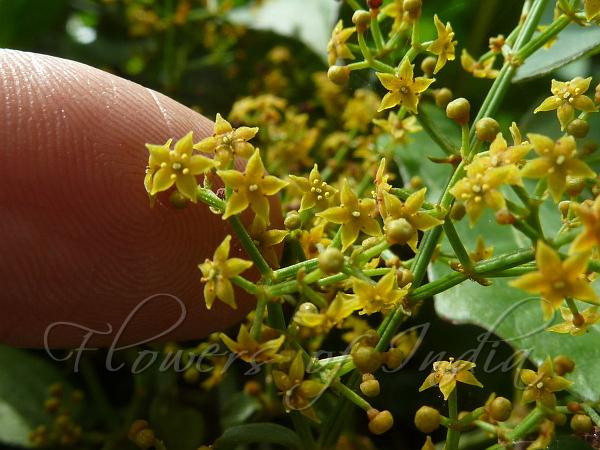|
| Indian Madder |
|

|

| File size | 238116 |
| Original date | 6/11/16 10:20 AM |
| Resolution | 1200 x 900 |
| Flash | Flash did not fire, auto |
| Focal length | 4.1mm |
| Exposure time | 1/200s |
| Aperture | 4.0 |
| Focus Distance | |
| Metering Mode | Multi-segment |
| Camera make | Panasonic |
| Camera model | DMC-TZ10 |
| Sensor type | OneChipColorArea |
|
|
|
|
Photo: |
Botanical name: Rubia cordifolia Family: Rubiaceae (Coffee family)
Synonyms: Rubia cordata, Galium cordifolium, Rubia scandens
Synonyms: Rubia cordata, Galium cordifolium, Rubia scandens
Indian Madder is a perennial climbing herb, that
can grow to 1.5 m in
height. The evergreen leaves are 5-10 cm long and 2-3 cm broad,
produced
in whorls of 4-7 starlike around the central stem. Leaves are
ovate-heartshaped, entire, pointed, heart-shaped at base, rarely
rounded, 3-9 palmately veined, upper surface mostly hairless and rough.
It climbs with
tiny hooks at the leaves and stems. The flowers are small, 3-5 mm
across, with five greenish yellow or pale yellow petals, in dense
racemes. Fruit is a small red to black berry, 4-6 mm diameter. The
roots can be over a metre long, up to 12 mm thick. Indian Madder was an
economically important source of a red pigment in many regions of Asia,
Europe and Africa. It was
extensively cultivated from antiquity until the mid nineteenth century.
The plant's roots contain an organic compound called Alizarin, that
gives its red colour to a textile dye known as Rose madder. It was also
used as
a colourant, especially for paint, that is referred to as Madder lake.
Indian Madder is found throughout the Himalayas, at altitudes of
300-2800 m. It is also found in the Western Ghats, Sri Lanka, Korea,
Mongolia, Russia
(Far East) and SE Asia. Flowering: June-August.
Medicinal uses: The plant is used both,
internally as well as externally. The roots of Manjistha are used for
medicinal purpose. Externally, Manjistha is highly recommended in skin
diseases associated with edema and oozing. The wound and ulcers dressed
with Manjistha ghrita heal promptly and get dried up and well cleansed.
The plant is used both,
internally as well as externally. The roots of Manjistha are used for
medicinal purpose. Externally, Manjistha is highly recommended in skin
diseases associated with edema and oozing. The wound and ulcers dressed
with Manjistha ghrita heal promptly and get dried up and well cleansed.
Medicinal uses:
 The plant is used both,
internally as well as externally. The roots of Manjistha are used for
medicinal purpose. Externally, Manjistha is highly recommended in skin
diseases associated with edema and oozing. The wound and ulcers dressed
with Manjistha ghrita heal promptly and get dried up and well cleansed.
The plant is used both,
internally as well as externally. The roots of Manjistha are used for
medicinal purpose. Externally, Manjistha is highly recommended in skin
diseases associated with edema and oozing. The wound and ulcers dressed
with Manjistha ghrita heal promptly and get dried up and well cleansed.
| Identification credit: Tabish | Photographed in Gangtok, Sikkim & Rajouri, J&K. |
• Is this flower misidentified? If yes,